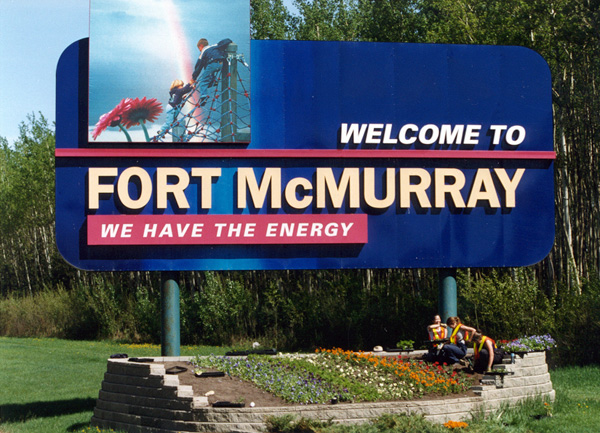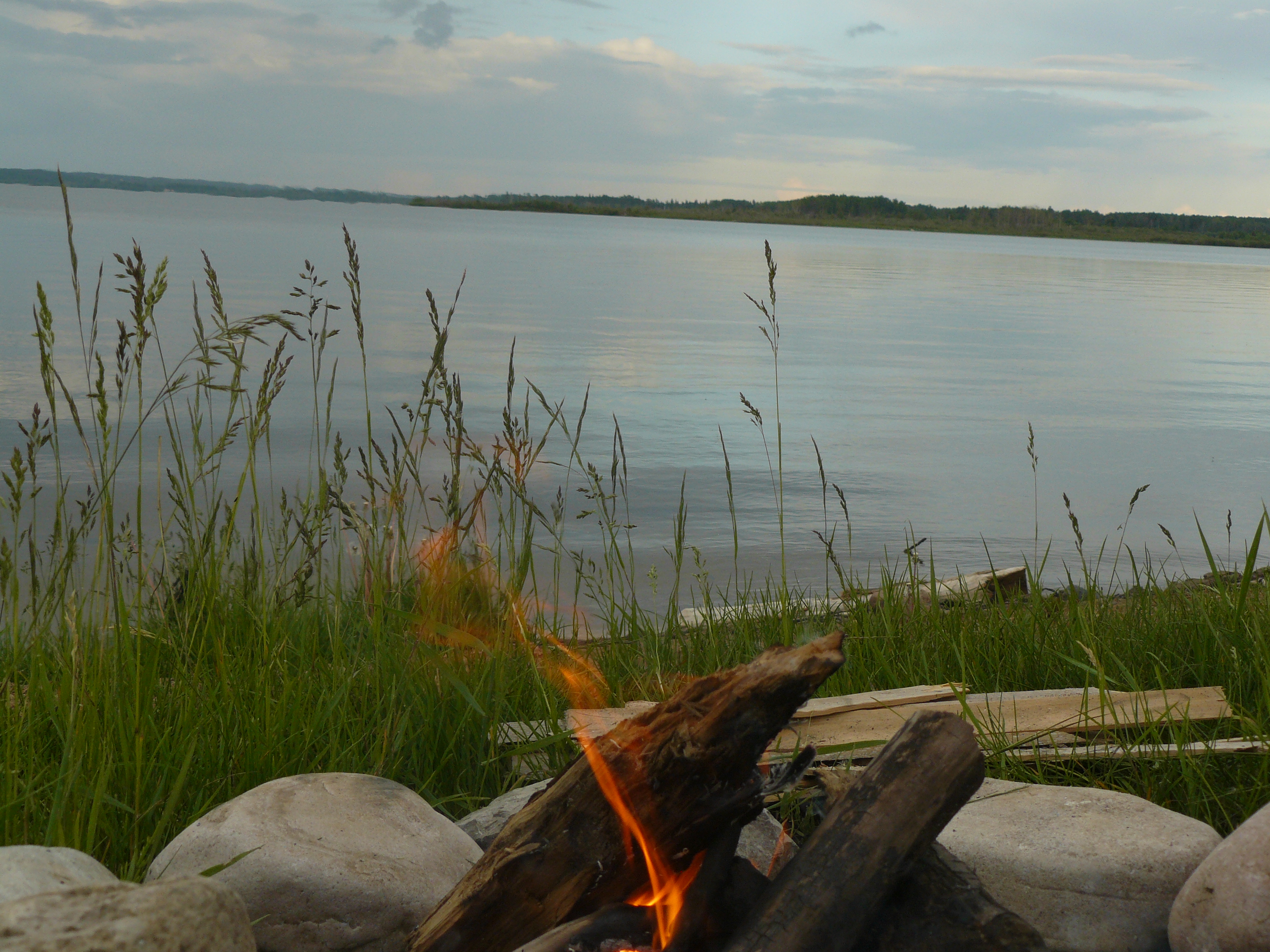It’s the last week of our supporter drive and boy, do we need you! Please help rabble.ca amplify democratic movements like the struggle against the Tar Sands. Become a monthly supporter.
The fifth and final Athabasca Tar Sands Healing Walk took place June 27 – 29, 2014 near Fort McMurray, Alberta. rabble.ca‘s Blogs Coordinator, Michael Stewart, attended to participate in, learn from and bear witness to this powerful event. The following is the first of a three-part series recording his experiences. Read his preamble in advance of the Walk here. Read part two here and part three here.
It’s a small plane that flies direct from Vancouver International Airport to Fort McMurray — 50 seats with no cabin power.
I took Vancouver’s Canada Line to the airport, a modern two-car train built by Hyundai just in time to impress Nordic and Germanic guests of the 2010 Winter Olympics. It’s a beautiful and frictionless light-rail transport, despite the contradiction that one of its chief purposes is to make it easier for travellers to access transportation that produces the largest amount of carbon emissions. Along the way I was struck by the vast fields of asphalt clustering around each SkyTrain platform, windshields of parked cars glistening in the West Coast sunshine. Beyond them lay the green peaks of the North Shore mountains as they reach out into the Strait of Georgia.
It’s a neat illustration of British Columbians’ vexed relationship with their surroundings. On one hand, we are faced with a natural beauty so overwhelming, some degree of environmentalism comes easily to the majority of the population; on the other, we remain largely oblivious to the way a lifestyle based on consumption and development threatens the land we want to protect.
I’m heading to the fifth and final Tar Sands Healing Walk, organized by the Keepers of the Athabasca, an Aboriginal group dedicated to protecting the region’s water supply. Last year, in the afterglow of Idle No More, between 500 and 600 people from across Canada — First Nation representatives, local residents, activists and others — took part in an eight-hour tour of a Suncor and Syncrude tar sands development site to survey the environmental impacts of mining bitumen in the Athabasca.
After a quick two-hour flight, I landed in Fort McMurray’s new international airport, open less than a month. When I exited my gate, two workers crouched, applying caulking to unfinsihed wall panels. A fellow passenger quipped “it still has that new airport smell” — and he was right. This, it struck me, is what a boomtown smells like.

“Not a protest”
The population of the Fort McMurray urban area is listed by the latest census at 72,944 with work site populations soaring by an astonishing 68 per cent from 2010 to 2012. Every highway and bridge seemed under construction and the city could definitely confess to having a bona fide rush hour. Later, during the walk itself at around 6:00 p.m., an endless line of coach-style buses flew past us on the Suncor – Syncrude access road, carrying workers for the next shift. The buses continued long after I lost count at fifty.
Those attending the Healing Walk camped together at Indian Beach on the shore of beautiful Gregoire Lake, the traditional territories of the Fort McMurray First Nation governed by Treaty 8. The narrow strip of land near the small town of Anzac is upstream and upwind of the Tar Sands. Even so, from our campsite we could hear the notorious sound cannons, punctuating the northern Alberta air with blasts meant to keep waterfowl from landing on tailings ponds.
“It’s not a rally, not a march, not a protest,” head coordinator Jesse Cardinal tells me, a line emphasized by many of the other organizers. “It is a ceremonial walk of prayer.” The goal is to create a “gathering place,” a “safe space” for local Indigenous communities to share their concerns about the way tar sand development is harming their communities. The traditional settler-activist approach, a demonstration or petition targeting the tar sands, will find no traction in a region where everyone you know works for the oil industry.

The rest of the country makes a habit of downloading the effects of climate change to the Tar Sands — or, even more generally, to “Alberta.” It’s the kind of shorthand that erases the full spectrum of environmental fallout that result at every point on the way from extraction to consumption. As you get closer to the source of the hydrocarbons that drive our lifestyle, our culture and our economy, you simply perform a different sleight-of-hand to arrive at the same question: what are you prepared to ignore in order to preserve the way that you live? For Canadians in Vancouver and Fort McMurray, the answer so far is unequivocally, if depressingly, “plenty.”
But the breadth of this complex relationship is mirrored by one that has seen forceful, if modest, pockets of resistance pop up across the nation against pipelines, fracking, tar sands development and oil-by-rail. Solidarity events with the Healing Walk took place in Victoria and Montreal with another walk planned for the Utah Tar Sands in August. On Sunday, the residents of Lac Mégantic gathered to remember the disastrous oil-by-rail crash last year. This expansion and amplification of defiance to a society addicted to oil is, perhaps counter-intuitively, one of the reasons this year’s Athabasca Healing Walk is billed as the last.
“It’s not that the work is stopping,” Cardinal says. “We want to go to other communities. The need for sharing information has grown.” Because of the overarching focus on Fort McMurray, Cardinal says, other communities are being neglected. Healing Walk organizers, in consultation with local residents and First Nations, are considering two other areas (getting “bombarded” by development, Cardinal says) for a future walk: Cold Lake, to the southeast of Fort Mac; or, to the west, the Peace Region in B.C. and Alberta.

Too much, too fast, too soon
Cold Lake in the Treaty 6 territory of the Beaver Lake Cree First Nation has had a known oil spill ongoing for a year, likely longer. Estimates that almost two million litres of a heavy crude and water mixture have infuriated locals, one of whom told me that Tar Sands development has already contaminated five lakes in the region. “They’re gone,” she said. “Like tailings ponds.” Cold Lake itself, the community’s chief water supply, could be next. “If we lose it, we’ll have no water at all.”
The Peace River region, the unceded traditional territory of the Lubicon Cree First Nation, is the other proposed candidate for a future healing walk. Several local families have abandoned their homes due to illness and poisoned livestock. The air reportedly hangs with noxious odours floating in from the in situ mining sites in the area, which boasts the third-largest bitumen deposit in the province. After years of reports and complaints, the Alberta government admitted this year that it was “concerned” about the odour in the Peace, but to date has not acted on the situation nor paid compensation to affected families.
“We want to start a broader conversation about the tar sands,” Cardinal tells me. “It’s just too much, too fast, too soon.” It’s not enough to just focus on Fort Mac, she says. “We want to focus on solutions.”
This focus was borne out by one of the key differences of this year’s walk from previous iterations through its keynote speakers and workshops. Strikingly, almost all the speakers were Aboriginal and most of them were women. The weekend hosted workshops on First Nations litigation, fighting pipelines, in situ tar sands mining and Aboriginal right and title, among others. The camp was buzzing with news from the recent Tsilqhot’in decision handed down from the Supreme Court, which strengthened the legal capacity of First peoples to defend their traditional lands. The small, determined group clearly shared a sense of common purpose and means across histories and geographies.
One of my tent neighbours, Kevin Henry, a Pune’laxutth in Coast Salish territory, is heading to the Unistot’en blockade next week. He comes from a strong Coast Salish bloodline, he told me, now diluted by the violence of colonialism, and he wants to do what his ancestors did — build community and solidarity with neighbouring nations. Two other new friends, twin sisters Blair and Brittany Williams, are members of the Aamjiwnaang First Nation, near Chemical Valley in Ontario, which faces problems familiar to the five host nations of the Healing Walk: health issues suffered by the community due to pollutants with little to no government or industry response to their complaints.
Along with the non-Aboriginal activists on hand, they’re here to build solidarity between distant communities, learn about the Tar Sands and bring the knowledge back home.
The second part of Michael’s report on the Tar Sands Healing Walk, “Water, Water everywhere and not a drop to drink,” can be read here. The third part, “The Tar Sands and the children we have never seenm,” is here.
“Welcome to Fort McMurray” image via Wikimedia Commons. All other photos by Michael Stewart.



